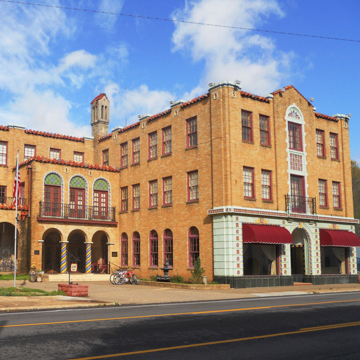The Continental Hotel Company of Springfield, Missouri, planned the hotel as a luxury establishment, with spaces to serve social gatherings for the community. The three-story building of forty rooms and four suites was constructed by contractor Will W. Johnson. Responding to the owner’s request for a design in the latest style, Eugene Johnson chose Spanish Colonial Revival, which was enjoying national popularity in the mid-1920s, and this is one of the state’s best examples. The L-shaped building, with facades on N. Main and E. Ridge Avenue, is set back from its corner site to allow access by automobile. The triple-arched principal entrance is defined by three polychrome glazed terra-cotta spiral columns with three similarly detailed round-arched windows above. The upper walls of buff brick include related terra-cotta ornamentation. Inside, painted bas-reliefs include depictions of the quetzal bird, the sacred bird of the Maya. In the 1960s, in response to increased travel by automobile, a two-story motel expansion was added around the west and north sides of the hotel. But motel competition along the major highways forced the hotel’s closure, and it was converted to housing for the elderly. Then in the 1990s, with the increase in heritage tourism, it reopened as a hotel.
You are here
Hotel Seville
If SAH Archipedia has been useful to you, please consider supporting it.
SAH Archipedia tells the story of the United States through its buildings, landscapes, and cities. This freely available resource empowers the public with authoritative knowledge that deepens their understanding and appreciation of the built environment. But the Society of Architectural Historians, which created SAH Archipedia with University of Virginia Press, needs your support to maintain the high-caliber research, writing, photography, cartography, editing, design, and programming that make SAH Archipedia a trusted online resource available to all who value the history of place, heritage tourism, and learning.















